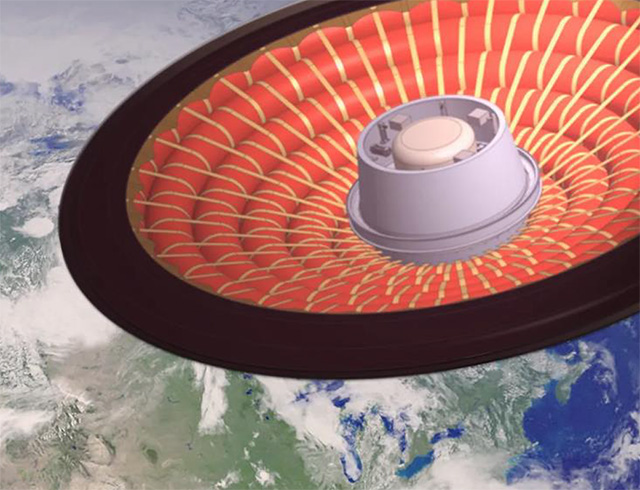
Audience
Educators, Students
Grade Levels
Grades K-4, Grades 5-8
Subject
Engineering Design, Physical Science, Space Science, Technology, Flight and Aeronautics, Forces and Motion, Solar System and Planets, Mars, Robotics, Space Vehicles
Type
Hands-on Activities, Lesson Plans / Activities
Introduction
One of the challenges NASA faces is how to deliver heavy payloads (i.e., experiments, equipment, and people) to destinations with an atmosphere, as current aerospace technology includes rigid aeroshells which are constrained by a rocket’s payload size. One potential answer is an inflatable aeroshell for the spacecraft that can be compactly stored for launch and then extended to a larger scale when the spacecraft reaches its destination. This technology enables the possibility of a variety of proposed NASA missions to destinations such as Mars, Venus, and Titan, and could also be helpful in returning spacecraft to Earth.
When a spacecraft enters an atmosphere, aerodynamic forces act upon it. Specifically, aerodynamic drag helps to slow it down, converting its kinetic energy into heat. Utilizing atmospheric drag is the most mass-efficient method to slow down a spacecraft. The atmosphere of Mars is much less dense than that of Earth and provides an extreme challenge for slowing down a spacecraft entering the planet’s atmosphere. Mars’ atmosphere is thick enough to provide some drag but too thin to decelerate the spacecraft as quickly as it would in Earth’s atmosphere. A large deployable aeroshell — an inflatable structure protected by a flexible heat shield — could act as a giant brake for the spacecraft as it traverses the Martian atmosphere. The large aeroshell creates more drag and begins slowing down in the upper reaches of the atmosphere, allowing the spacecraft to decelerate sooner, at higher altitude, while experiencing less intense heating.
In this activity, participants will design a drag device system to slow the descent of a weighted spacecraft and understand how a drag system helps to safely reduce the velocity of a spacecraft during entry or re-entry.
![]() Grade Range: 3-8
Grade Range: 3-8
![]() Time Needed: 90 Minutes
Time Needed: 90 Minutes
![]() Materials List
Materials List
Ensure that students have:
-
- Scissors
- Rulers
- Clear tape
- Digital scale or balance
- Thin string (e.g., embroidery thread, fishing line)
- Small sealable bag, one per group
- Washers, marbles, or pennies to serve as mass
- Hole punch and hole reinforcements or stickers
- Cardstock or old file folders
- Spacecraft template or cup glued to a paper plate
- Tall ladder or overhang above a stairway or common area
- Materials to make drag device (e.g., trash bags, grocery bags, wrapping paper, tissue paper, plastic tablecloths)
![]() Safety
Safety
Ensure that:
-
- Students practice safe cutting techniques when building their drag device systems.
- Students do not stand on any unstable surfaces, such as tables or chairs, when performing their drop tests.
- Students’ drag device systems do not contain sharp or pointed surfaces that could present a hazard during the drop tests.
- The drop zone is clear of students and items that may be in the path of falling prototypes.
Activity Procedure
-
- Gather and prepare all listed supplies. Group participants in teams of three to four. Set up testing stations with safety equipment.
- Ask students: Have you ever noticed when a bird is preparing to land, it typically has its wings spread out? Why do you think that is the case?
- Have students drop two pieces of paper, one crumpled and one flat (the only variable should be the shape and surface area of the paper). What do they notice as the pieces fall?
Facilitate the Challenge
-
- Teams will use the provided template to build a spacecraft and will place a plastic bag with 20 to 30 grams of mass, representing added “cargo”, inside the spacecraft (a paper plate with a cup glued to the surface could also be used as an alternative to the template).
- Allow teams to see the available materials for creating their drag device system. The total design (i.e., spacecraft, cargo, and drag device) cannot exceed 50 grams.
- Each team will brainstorm and sketch their design.
- One participant from each team should gather the needed materials.
- Teams will build and test their drag device system by dropping the spacecraft from at least 2 meters high. Compare drop times with and without the drag device system.
Challenge Questions
-
- Which drag device system characteristics provided the most reliable results?
- Which design had the slowest descent (longest drop time)?
- What information could engineers working on this project learn from your team’s results?
Extensions
-
- Have participants redesign their drag devices to improve their performance.
- Repeat the challenge but give a constraint for the drag device. For example, the drag device must have at least five separate angled edges.
- Calculate surface area for each drag device. Surface area can be estimated by tracing the shape of the drag device onto centimeter grid paper and counting squares. Compare drop time results for various surface areas. Plot surface area versus drop time on a graph.
Career Connection
Slowing down in space requires the development of new technologies to aid in our exploration of other worlds. This requires a team of people with diverse expertise and specialized skills working together to create the science and technology payloads that we will need. Below are just a couple of examples of the careers involved developing these technologies.
Engineering careers use science principles to design products and improve systems and manufacturing processes. There are a variety of different types of engineering careers, such as electrical and mechanical.
Robotics careers are involved in the development, implementation, and the maintenance of technologies that deploy robotics. They also ensure that they operate efficiently and safely.
Other Resources
Design a Spacecraft Drag System like NASA
LOFTID Gets Pumped Up for Launch
LOFTID’s Next Stop: Space!
LOFTID Animation




























